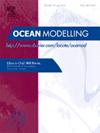基于rcunet的多日时间序列海面风应力模型及其在ENSO模拟中的应用
IF 2.9
3区 地球科学
Q2 METEOROLOGY & ATMOSPHERIC SCIENCES
引用次数: 0
摘要
在El Niño-Southern涛动(ENSO)研究的传统海洋-大气耦合模型中,通常使用统计方法来表示海表温度(SST)月平均异常和风应力(τ)之间的瞬时线性关系。近年来,深度学习技术为ENSO建模提供了广阔的前景,神经网络与动态模型的集成是一个活跃的研究领域。本研究将残差卷积块和卷积块注意模块(Res-CBAM块)整合到原始UNet配置中,构建了一个新的基于rcunet的τ模型,表示为τ rcunet,该模型使用多天时间间隔(TIs)中的SST异常(ssta)来推导每日τ响应。对ti进行敏感性试验,以说明每日τ响应如何依赖于使用多日海温强迫的方式;与不同TI的比较表明,当TI=3 d时,τ rcunet模型能更准确地反映ssta与τ异常之间的关系。接下来,利用τ rcunet模型获得的逐日τ异常在海洋实验中强制建立了一个中间海洋模型(IOM),该模型显示了典型ENSO事件期间海洋和大气异常的相干相变和时空演变,这凸显了基于dl的大气τ模型结合多日海表温度时间序列信息用于海洋模拟的优势。在此基础上,建立了一种新的中间耦合模式ICM- rcunet,该模式将以奇异值分解(SVD)分析为代表的原始大气分量替换为以τRCUNet模式为代表的大气分量,与多日海温强迫进行逐日耦合。ICM-RCUNet模拟显示了热带太平洋大气和海洋状态的年际振荡,证明了将基于物理的海洋动力模式与大气神经网络相结合在enso相关研究中的适用性。讨论了使用神经网络对海洋和耦合建模的进一步影响。本文章由计算机程序翻译,如有差异,请以英文原文为准。
An RCUNet-based sea surface wind stress model with multi-day time sequence information incorporated and its applications to ENSO modeling
In traditional ocean-atmosphere coupled modeling for El Niño-Southern Oscillation (ENSO) studies, statistical methods are typically used to represent the instantaneous linear relationship between monthly-averaged anomalies of sea surface temperature (SST) and wind stress (τ). Recently, deep learning (DL) techniques have presented promising prospects for ENSO modeling, and the integration of neural networks (NNs) with dynamical models is an active research area. This study incorporates the Residual convolution blocks and a Convolutional Block Attention Module (the Res-CBAM block) into the original UNet configuration to build a new RCUNet-based model, denoted as , which uses SST anomalies (SSTAs) during multi-day time intervals (TIs) to derive daily responses. Sensitivity tests to TIs are performed to illustrate how daily responses are dependent on the way multi-day SST forcings are used; the comparisons with different TIs show that when taking TI=3 days, the model can more precisely represent the relationship between SSTAs and anomalies. Next, daily anomalies obtained from the model are used to force an intermediate ocean model (IOM) in the ocean-only experiments, displaying coherent phase transitions and spatiotemporal evolutions of oceanic and atmospheric anomalies during typical ENSO events, which highlights the advantages of using the DL-based atmospheric model with multi-day SST time sequence information incorporated for ocean modeling. Furthermore, a new intermediate coupled model (ICM) is formed, named the ICM-RCUNet, in which the original atmospheric component represented by singular value decomposition (SVD) analyses is replaced by the model that is used as an atmospheric component, and a daily coupling is conducted with multi-day SST forcings. The ICM-RCUNet simulations exhibit interannual oscillations of atmospheric and oceanic states in the tropical Pacific, demonstrating the applicability of integrating physics-based dynamical ocean models with atmospheric NNs in ENSO-related studies. Further implications for ocean and coupled modelings using NNs are discussed.
求助全文
通过发布文献求助,成功后即可免费获取论文全文。
去求助
来源期刊

Ocean Modelling
地学-海洋学
CiteScore
5.50
自引率
9.40%
发文量
86
审稿时长
19.6 weeks
期刊介绍:
The main objective of Ocean Modelling is to provide rapid communication between those interested in ocean modelling, whether through direct observation, or through analytical, numerical or laboratory models, and including interactions between physical and biogeochemical or biological phenomena. Because of the intimate links between ocean and atmosphere, involvement of scientists interested in influences of either medium on the other is welcome. The journal has a wide scope and includes ocean-atmosphere interaction in various forms as well as pure ocean results. In addition to primary peer-reviewed papers, the journal provides review papers, preliminary communications, and discussions.
 求助内容:
求助内容: 应助结果提醒方式:
应助结果提醒方式:


